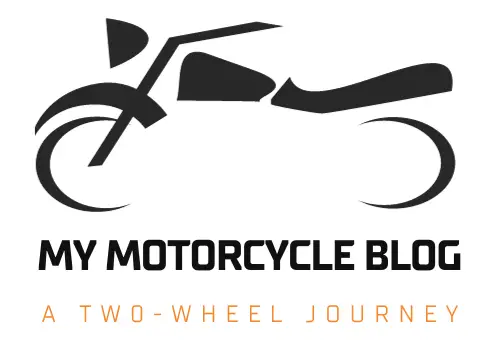After the front sprocket change on my TBR7, I have been chomping at the bit to change the rear sprocket. I did so, and here are the steps I followed. Remember, these steps apply to the TBR7’s close cousins like the Hawk 250, so I hope this inspires my Hawk brothers, who also want to upgrade.
Recap what I did with the front sprocket since this upgrade is related to it. I changed my TBR7’s stock 15 tooth front sprocket to a 17 tooth front sprocket. This upgrade had a couple of benefits:
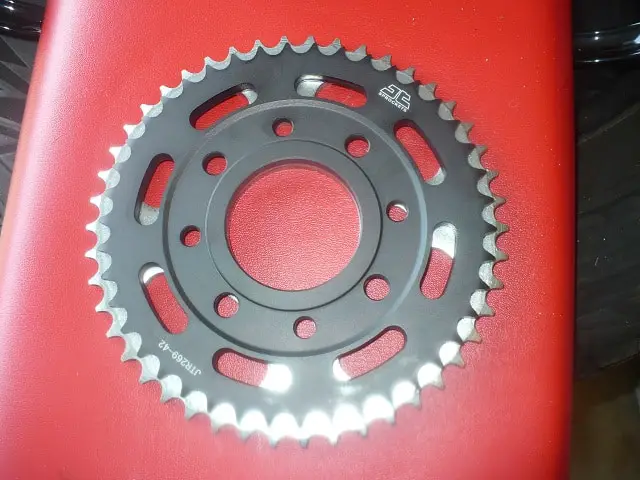
1.- With its more teeth, the front sprocket could move more chain links per engine output shaft revolution. This size change translates to the same engine rpm. The chain moves faster and is delivered faster to the rear sprocket. Which, of course, increases the top speed of the motorcycle. Which it did!
2.- With the larger front sprocket, I had more range per gear. Meaning, I don’t max engine RPMs as fast, requiring me to shift up sooner. The most significant benefit was 1st gear. With the stock front sprocket, I had to shift into 2nd almost immediately. Now with the larger front sprocket, I can use the 1st gear longer.
If The Front Sprocket Upgrade Worked, Why Not Go Bigger?
I wish. Without modifying the front sprocket case, the max front sprocket size I could upgrade to was 17 teeth. However, my motorcycle’s usability increase motivated me to make changes to the rear sprocket.
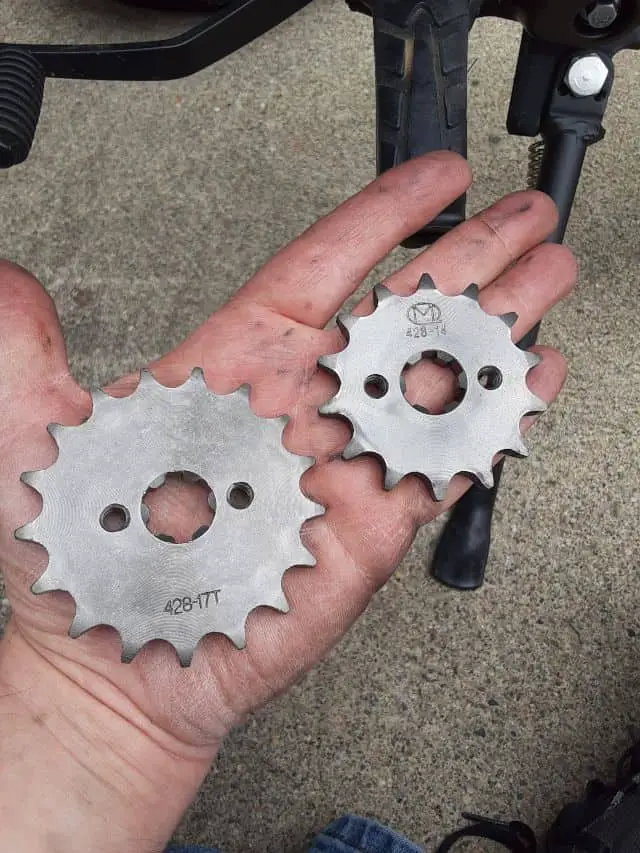
Found the speed benefits of increasing the front sprocket size can also be replicated by decreasing the rear sprocket size. Sound the opposite, which it is, but the results are the same: more speed and more gear usability.
Is A Smaller Rear Sprocket Faster?
The whole goal of making the TBR7 faster is to get the rear wheel to turn more quickly. The engine has an rpm out limit. Too fast, and the engine flies apart. So imagine the max RPM is fixed, so changing the size of the sprockets converts the max engine rpm into faster wheel RPMs. Well, that’s the goal.
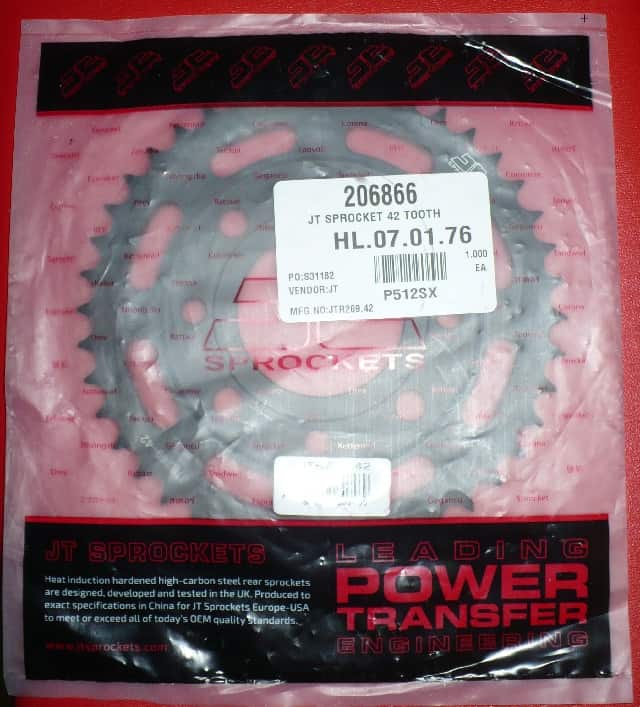
A smaller rear sprocket makes a minor change to have the rear wheel revolve faster for the same engine output shaft RPMs.
Do Fewer Teeth On A Rear Sprocket Make You Go Faster?
Yes, but I know what you are thinking, and so too I was. Why not go to a ridiculously small rear sprocket? Then I can increase the number of rear-wheel revolutions for every chain revolution. I’ll address big picture issue:
With a too-small rear sprocket, you can lose so much torque that the engine will stall trying to accelerate. This over-shrinking will require more clutch play and could lead to premature clutch wear and failure. Also, going uphill will put a tremendous toll on the engine, and you can lose speed from the engine load.
So there must be a happy balance between torque and speed to keep the motorcycle usable and fun.
What Were The Rear Sprocket Recommendations?
Now face it, there seem to be more Hawk 250 owners than TBR7s. This difference is expected since the Hawk 250 is more off-road oriented(larger wheels and more aggressive stock tires) than the TBR7. And people who buy these cheap Chinese dual-sport motorcycles buy them for off-road use mostly. My points:
1.- There are more Hawk 250 posts, and although similar to this post, individual owner goals have to be taken into account. I want a higher road speed. Hawk 250 owners typically want speed, but without giving up climbing power. As a TBR7 owner, I am interested in increasing the TBR7’s on-road characteristics. So speed is my goal.
2.- The Hawk 250 wheels are larger, so minor sprocket changes can result in higher-stop speeds.
3.- The Hawk 250 comes with a larger stock rear sprocket, so again, just going to my stock TBR7 rear sprocket (46 teeth) could result in a significant speed increase for the Hawk 250.
Now knowing this, I was able to weed through forum posts and websites information carefully. With my upgraded 17 tooth front sprocket, I concluded that I should balance road speed and minimize acceleration power using a 40 tooth to a 42 tooth rear sprocket.
So from the options a 40 tooth, 41 teeth, or a 42 tooth rear sprocket, I am going with the 42 tooth version. It should boost maximum speed, going from the stock 46 tooth sprocket to a 42 tooth version. Almost a 9% reduction in sprocket teeth. This change should directly increase the number of RPMs to the rear wheel.
Just in case you go the other direction for rear sprockets?
What does a bigger rear sprocket do?
The opposite of what I explained. This change to a larger rear sprocket will lower the maximum RPMs to the rear wheel for a constant maximum engine output shaft RPMs. Now the loss of speed is sacrificed for a greater torque delivered to the rear wheel, translating into better acceleration and climbing power.
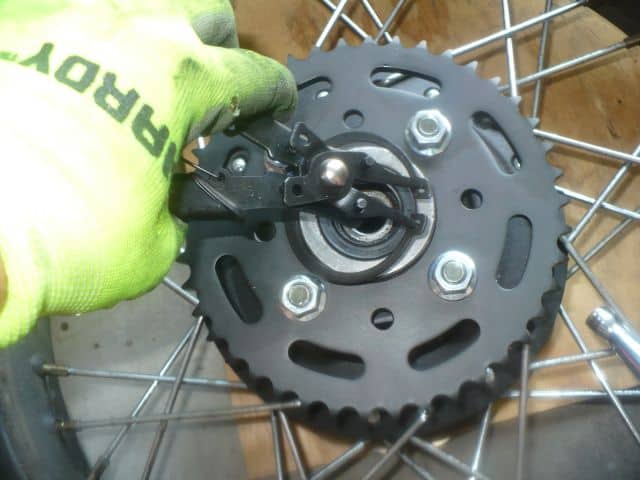
Do lower gears(a larger rear sprocket) increase torque?
The engine torque is by design. How that torque and speed are delivered to the rear wheel is affected by the sprocket gearing. By increasing the size of the rear sprocket, you are delivering more torque to the rear wheel.
Before going through how I upgraded TBR7’s rear sprocket, I have to warn you. I am omitting some ‘bloopers’ that occurred during the process. I want to have a clean list of steps to show here but will include a later post about how not all went well, so you don’t repeat my mistakes. Check back for the Rear Sprocket and Studs Blooper Post.
Now that is said, let’s get into my upgrade, see my post: TBR7 Rear Sprocket and Studs Upgrade.
Click To See My Recommended
TBR7 Upgrades

Hi I’m Tom, A New Motorcycle Rider and Blog Author.
I am a new rider(Pa Learners Permit at the end of 2020, and I received a Pa Motorcycle License in 2021 after passing a Motorcycle Safety Course).
I bought my first motorcycle, a TaoTao TBR7, at the beginning of 2021 and have been doing upgrades on that motorcycle since.
I added to my motorcycle collection by buying a Boom Vader Gen 2 in 2022, and that Grom-Clone motorcycle has been upgraded by me as well.
I continue to ride my Boom Vader Gen 2 motorcycle as well as my TaoTao TBR7 dual-sport bike.
Read more on my About Me page.
Fun Fact: I’ve only been on one group ride.
